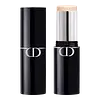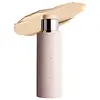Dior Forever Skin Perfect Multi-Use Foundation Stick Versus Westman Atelier Vital Skin Foundation Stick
What's inside
What's inside
 Key Ingredients
Key Ingredients

 Benefits
Benefits

 Concerns
Concerns

 Ingredients Side-by-side
Ingredients Side-by-side

C15-19 Alkane
SolventCaprylic/Capric Triglyceride
MaskingHelianthus Annuus Seed Wax
Skin ConditioningMica
Cosmetic ColorantSaccharomyces Ferment
Skin ConditioningCoco-Caprylate/Caprate
EmollientSilica
AbrasivePhytosteryl/Octyldodecyl Lauroyl Glutamate
Skin ConditioningPolyglyceryl-2 Triisostearate
EmulsifyingIris Florentina Root Extract
MaskingAluminum Hydroxide
EmollientParfum
MaskingBrassica Campestris Seed Oil
Skin ConditioningEuphorbia Cerifera Wax
Copernicia Cerifera Wax
Lauroyl Lysine
Skin ConditioningDisteardimonium Hectorite
StabilisingOpuntia Ficus-Indica Flower Extract
Skin ConditioningCamelina Sativa Seed Oil
Skin ConditioningPentaerythrityl Tetra-Di-T-Butyl Hydroxyhydrocinnamate
AntioxidantWater
Skin ConditioningLinalyl Acetate
MaskingAnethole
MaskingTocopherol
AntioxidantPotassium Sorbate
PreservativeSodium Benzoate
MaskingCI 77891
Cosmetic ColorantCI 77491
Cosmetic ColorantCI 77492
Cosmetic ColorantCI 77499
Cosmetic ColorantC15-19 Alkane, Caprylic/Capric Triglyceride, Helianthus Annuus Seed Wax, Mica, Saccharomyces Ferment, Coco-Caprylate/Caprate, Silica, Phytosteryl/Octyldodecyl Lauroyl Glutamate, Polyglyceryl-2 Triisostearate, Iris Florentina Root Extract, Aluminum Hydroxide, Parfum, Brassica Campestris Seed Oil, Euphorbia Cerifera Wax, Copernicia Cerifera Wax, Lauroyl Lysine, Disteardimonium Hectorite, Opuntia Ficus-Indica Flower Extract, Camelina Sativa Seed Oil, Pentaerythrityl Tetra-Di-T-Butyl Hydroxyhydrocinnamate, Water, Linalyl Acetate, Anethole, Tocopherol, Potassium Sorbate, Sodium Benzoate, CI 77891, CI 77491, CI 77492, CI 77499
Caprylic/Capric Triglyceride
MaskingIsononyl Isononanoate
EmollientIsodecyl Neopentanoate
EmollientDicalcium Phosphate
AbrasiveMicrocrystalline Wax
Emulsion StabilisingSqualane
EmollientPolyethylene
AbrasiveVp/Hexadecene Copolymer
Synthetic Wax
AbrasiveDisteardimonium Hectorite
StabilisingHydrogenated Polyisobutene
EmollientSilica
AbrasiveNylon-12
Camellia Oleifera Seed Oil
Skin ConditioningHydrogenated Coconut Oil
EmollientPhytosphingosine
Skin ConditioningButyl Stearate
EmollientIsostearyl Alcohol
EmollientAlcohol
AntimicrobialWater
Skin ConditioningPentaerythrityl Tetra-Di-T-Butyl Hydroxyhydrocinnamate
AntioxidantButylene/Ethylene/Styrene Copolymer
Ethylene/Propylene/Styrene Copolymer
Mica
Cosmetic ColorantDibutyl Lauroyl Glutamide
Skin ConditioningRubus Idaeus Leaf Cell Culture
Skin ConditioningTin Oxide
AbrasiveCaprylic/Capric Triglyceride, Isononyl Isononanoate, Isodecyl Neopentanoate, Dicalcium Phosphate, Microcrystalline Wax, Squalane, Polyethylene, Vp/Hexadecene Copolymer, Synthetic Wax, Disteardimonium Hectorite, Hydrogenated Polyisobutene, Silica, Nylon-12, Camellia Oleifera Seed Oil, Hydrogenated Coconut Oil, Phytosphingosine, Butyl Stearate, Isostearyl Alcohol, Alcohol, Water, Pentaerythrityl Tetra-Di-T-Butyl Hydroxyhydrocinnamate, Butylene/Ethylene/Styrene Copolymer, Ethylene/Propylene/Styrene Copolymer, Mica, Dibutyl Lauroyl Glutamide, Rubus Idaeus Leaf Cell Culture, Tin Oxide
Ingredients Explained
These ingredients are found in both products.
Ingredients higher up in an ingredient list are typically present in a larger amount.
This ingredient is an emollient, solvent, and texture enhancer. It is considered a skin-softener by helping the skin prevent moisture loss.
It helps thicken a product's formula and makes it easier to spread by dissolving clumping compounds.
Caprylic Triglyceride is made by combining glycerin with coconut oil, forming a clear liquid.
While there is an assumption Caprylic Triglyceride can clog pores due to it being derived from coconut oil, there is no research supporting this.
Learn more about Caprylic/Capric TriglycerideDisteardimonium Hectorite comes from the clay mineral named hectorite. It is used to add thickness to a product.
It can also help stabilize a product by helping to disperse other ingredients.
Hectorite is a rare, white clay mineral.
Learn more about Disteardimonium HectoriteMica is a naturally occurring mineral used to add shimmer and color in cosmetics. It can also help improve the texture of a product or give it an opaque, white/silver color.
Serecite is the name for very fine but ragged grains of mica.
This ingredient is often coated with metal oxides like titanium dioxide. Trace amounts of heavy metals may be found in mica, but these metals are not harmful in our personal products.
Mica has been used since prehistoric times throughout the world. Ancient Egyptian, Indian, Greek, Roman, Aztec, and Chinese civilizations have used mica.
Learn more about MicaPentaerythrityl Tetra-Di-T-Butyl Hydroxyhydrocinnamate (long name, huh?) is a synthetic antioxidant.
It is used to help stabilize other antioxidants or prevent the color from changing in a product.
As an antioxidant, it helps fight free-radical molecules. Free-radical molecules are capable of damaging our cells and other genetic material. Thus, antioxidants may reduce the signs of aging.
This ingredient is oil-soluble.
Learn more about Pentaerythrityl Tetra-Di-T-Butyl HydroxyhydrocinnamateSilica, also known as silicon dioxide, is a naturally occurring mineral. It is used as a fine, spherical, and porous powder in cosmetics.
Though it has exfoliant properties, the function of silica varies depending on the product.
The unique structure of silica enhances the spreadability and adds smoothness, making it a great texture enhancer.
It is also used as an active carrier, emulsifier, and mattifier due to its ability to absorb excess oil.
In some products, tiny microneedles called spicules are made from silica or hydrolyzed sponge. When you rub them in, they lightly polish away dead skin layers and enhance the penetration of active ingredients.
Learn more about SilicaWater. It's the most common cosmetic ingredient of all. You'll usually see it at the top of ingredient lists, meaning that it makes up the largest part of the product.
So why is it so popular? Water most often acts as a solvent - this means that it helps dissolve other ingredients into the formulation.
You'll also recognize water as that liquid we all need to stay alive. If you see this, drink a glass of water. Stay hydrated!
Learn more about Water